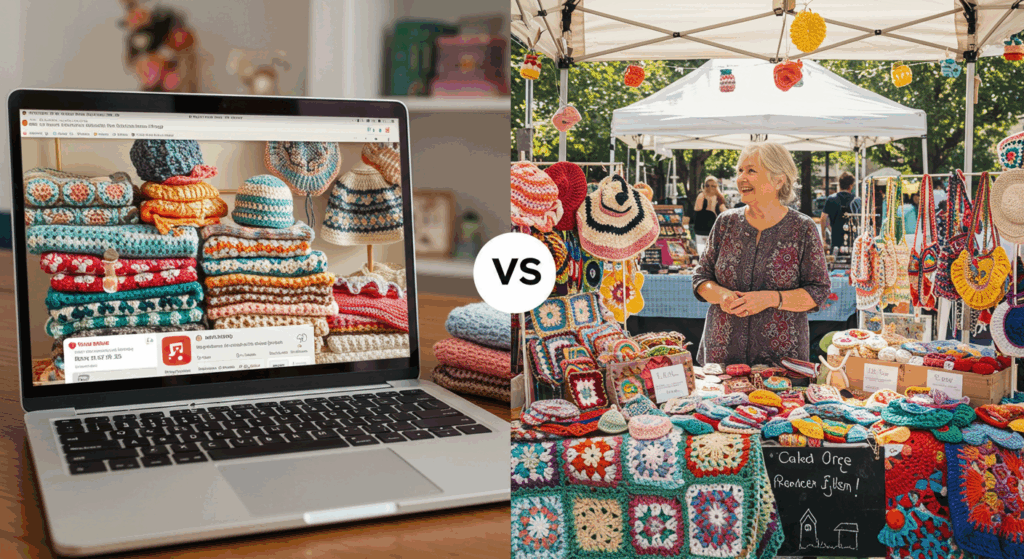Introduction: The Joy of Turning Yarn into Profit
Imagine this: you’re curled up on the couch, a soft ball of yarn in one hand, a crochet hook in the other, and your latest creation slowly coming to life. Maybe it’s a cozy beanie, a whimsical amigurumi, or a delicate doily. Now imagine that same hobby not just bringing you joy—but also paying your bills. Sounds dreamy? For thousands of crafters around the world, it’s very real.
Selling handmade crochet items has become more than a side hustle; it’s a full-time career for many. But here’s the big question: Where should you sell your crochet creations to get the best results? Should you list your pieces on Etsy, the global marketplace for handmade goods? Or would you have better luck at a local farmers market, craft fair, or pop-up shop?
This isn’t just about choosing a sales platform—it’s about building a sustainable, fulfilling business that fits your lifestyle. In this article, we’ll dive deep into the pros and cons of selling crochet on Etsy versus local markets. We’ll look at costs, customer reach, time investment, marketing, and even the emotional rewards of each option.
Whether you’re just starting out or looking to scale your existing crochet business, this guide will help you make an informed decision. So grab your favorite cup of tea, settle in, and let’s unravel the best path for your creative journey.
1. Reach and Audience: Global vs. Community
One of the biggest differences between Etsy and local markets comes down to audience size and reach.
When you open an Etsy shop, you’re instantly connected to over 90 million active buyers worldwide. That’s not just impressive—it’s transformative. A single listing can be discovered by someone in Tokyo, Paris, or Buenos Aires, all while you sleep. This kind of global exposure is nearly impossible to achieve at local events.
For example, Sarah, a crocheter from Colorado, started selling baby booties on Etsy during the pandemic. Within six months, her items were being shipped to Australia, Germany, and Canada. “I never thought my little bunnies would travel the world,” she says. “Now I get messages from moms saying their babies wear them every day. It’s surreal.”
On the flip side, local markets offer something Etsy can’t replicate: face-to-face connection. At a craft fair, you can see a customer’s eyes light up when they hold your handmade blanket. You can explain your materials, share your story, and build a personal relationship on the spot.
And there’s real value in that. According to a 2023 survey by the American Craft Council, 78% of buyers at local craft fairs said they preferred buying directly from the artist because it felt more authentic and meaningful.
So which is better? It depends on your goals. If you want scale, visibility, and passive income, Etsy gives you a powerful platform. If you value community, personal interaction, and immediate feedback, local markets might be your sweet spot.
But here’s the good news: you don’t have to choose just one. Many successful crocheters use both—Etsy for steady online sales and local markets for branding, testing new products, and connecting with their community.
2. Costs and Fees: What’s the Real Price of Selling?
Let’s talk money—because every sale isn’t pure profit. Both Etsy and local markets come with costs, but they’re very different in nature.
On Etsy, the fees are straightforward:
- $0.20 per listing (lasts 4 months)
- 6.5% transaction fee on each sale
- Payment processing fee (around 3% + $0.25)
- Optional: Etsy Ads (you set your own budget)
That means if you sell a $30 crochet tote, you’ll pay about $3.40 in fees. Not bad—but it adds up, especially if you have hundreds of listings.
The upside? No upfront costs to open a shop. You don’t need inventory, a booth, or travel expenses. You can start small, test products, and scale as you go.
Now, let’s look at local markets. Here, the costs are more tangible:
- Booth rental: $25–$150 per event
- Travel and gas
- Display materials (tables, banners, lighting)
- Packaging and business cards
- Time (setup, selling, breakdown)
For instance, renting a booth at a weekend craft fair might cost $80. If you don’t make at least $150 in sales, you’re barely breaking even. And if it rains? Attendance drops, and so do your chances.
But there are hidden benefits. At local events, you keep 100% of every sale (no platform fees). Plus, cash transactions mean instant payment—no waiting for Etsy payouts.
Also, local markets are great for upselling and bundling. You can offer a “buy two, get 10% off” deal on the spot, or throw in a free coaster with a purchase. These small touches boost average order value and create goodwill.
Pro Tip: Track your expenses! Use a simple spreadsheet to log booth fees, materials, and travel. Compare that to your sales to calculate your real profit margin. This will help you decide which option gives you the best return.
3. Time Investment: Passive vs. Hands-On Effort
Time is your most valuable resource—especially when you’re running a creative business.
Selling on Etsy is often called “passive income,” but that’s a bit of a myth. Sure, your shop runs 24/7, but it takes serious effort to set up and maintain.
Here’s what Etsy requires:
- Taking high-quality photos (natural light, clean background)
- Writing clear, keyword-rich descriptions
- Optimizing titles and tags for search
- Responding to customer messages
- Packing and shipping orders
- Managing reviews and customer service
And let’s not forget marketing. Just listing an item doesn’t guarantee sales. You’ll need to promote your shop through social media, Pinterest, or Etsy Ads.
The good news? Once your listings are live, they can sell while you sleep. You can take a weekend off, and orders still come in. That’s the beauty of an online store.
Now, contrast that with local markets. These are intense, hands-on events. You’ll spend hours:
- Setting up your booth (often by 7 a.m.)
- Standing for 6–8 hours
- Talking to dozens of customers
- Handling cash and card payments
- Packing everything back up (often in the rain!)
It’s exhausting—but also energizing. Many crafters say they feel more “alive” at markets because of the human interaction and instant feedback.
Plus, local events force you to refine your pitch. When someone stops at your table, you have 10 seconds to grab their attention. That teaches you how to communicate the value of your work—skills that translate online, too.
So, which is less time-consuming? Etsy, in the long run. But it demands consistency. You can’t just list five items and disappear. You need to treat it like a real business.
Local markets, meanwhile, are time-intensive but episodic. You work hard for one day, then have weeks to rest, create, and plan.
Balance is key. If you’re a busy parent or have a full-time job, Etsy might fit better into your schedule. If you crave structure and social energy, local markets could be more rewarding.
4. Marketing and Visibility: Who Finds You First?
Marketing is the engine that drives sales—whether you’re online or in person.
On Etsy, visibility depends on search algorithms and SEO. Think of it like Google for handmade goods. If your listing doesn’t show up in search, no one will see it.
That’s why keywords matter. For example, instead of naming your item “Cute Crochet Bunny,” try “Handmade Crochet Baby Gift – Amigurumi Rabbit – Newborn Present – Organic Cotton – Gender Neutral.” This longer title includes terms buyers actually search for.
Etsy also rewards shops that:
- Get reviews quickly
- Ship fast
- Have consistent sales
New sellers often struggle at first because they lack reviews. That’s where Etsy Ads can help. For as little as $1–$5 per day, you can boost your listings to appear in search results.
But here’s a secret: social media is your best friend. Sharing your Etsy items on Instagram, TikTok, or Pinterest can drive traffic directly to your shop. A single viral TikTok video can result in hundreds of sales overnight.
Now, let’s talk about local markets. Here, marketing happens in real time.
Your booth is your advertisement. A clean, colorful display with clear signage (“Handmade in USA,” “100% Cotton,” “Custom Orders Available”) grabs attention. Props like mannequins, baskets, or themed decorations make your table stand out.
And don’t underestimate the power of free samples. One crocheter, Maria, gives out tiny keychain amigurumis. “People love them,” she says. “They take photos, tag me on Instagram, and suddenly I have new followers.”
Local markets also open doors to collaborations. You might meet a jewelry maker who wants to bundle your scarves with her necklaces, or a café owner who invites you to host a crochet workshop.
Hybrid Tip: Use local events to grow your online presence. Add a sign that says, “Follow us on Instagram for new drops!” or “Visit our Etsy shop for more styles.” This bridges the gap between offline and online sales.
5. Customer Experience: Building Trust and Loyalty
How your customers feel about buying from you can make or break your business.
On Etsy, the experience is digital and transactional. Buyers can’t touch your product before purchasing, so they rely on:
- Photos
- Descriptions
- Reviews
- Shop policies
That’s why professional presentation matters. Blurry photos or vague descriptions will scare buyers away. Include multiple angles, close-ups of stitches, and a photo showing scale (e.g., a crochet hat on a mannequin or next to a coffee mug).
Also, communication builds trust. Respond to messages quickly. Send a thank-you note with each order. Offer tracking and updates. These small touches turn one-time buyers into repeat customers.
Many Etsy sellers create branded packaging—tissue paper with their logo, stickers, or a handwritten note. It makes the unboxing feel special, and customers often share it on social media.
Now, at local markets, the experience is immediate and emotional.
Customers can touch, try on, and ask questions. They see the care in your stitches, smell the yarn, and hear your passion when you talk about your craft. This builds a deep connection.
And because you’re there in person, you can solve problems on the spot. A customer says a scarf is too long? You can suggest ways to style it. They want a custom color? You can take their order right then.
This personal touch leads to higher customer loyalty. People don’t just buy your product—they buy into you.
Case Study: Jen, a crocheter from Oregon, noticed that her local customers often returned months later, even if they lived far away. “They remember me,” she says. “They bring friends, send me photos of their pets wearing my dog sweaters, and support me online too.”
The lesson? Both platforms build loyalty—but in different ways. Etsy rewards consistency and professionalism. Local markets reward authenticity and connection.
6. Flexibility and Growth: Can You Scale Your Business?
Let’s talk long-term. Where can your crochet business grow the most?
Etsy offers scalability. With the right strategy, you can go from selling a few items a month to running a six-figure shop. Some top Etsy sellers make over $10,000 per month from crochet alone.
How? By:
- Creating digital patterns (sell once, profit forever)
- Offering custom orders
- Building a brand with consistent style and packaging
- Hiring help for shipping or even production (if using assistants)
You can also expand into wholesale or private labeling. Some Etsy sellers supply their products to boutiques or gift shops.
But scaling on Etsy requires systems. You’ll need inventory management, shipping labels, and possibly automation tools like Printful (for print-on-demand items).
Now, local markets are harder to scale—but not impossible.
You’re limited by geography, time, and physical space. You can’t be at every market, and you can only carry so much inventory.
However, local success can fuel online growth. A strong local reputation builds credibility. Customers who meet you in person are more likely to follow you online, leave reviews, and refer friends.
Plus, local events are great for testing new products. You can bring five versions of a new design and see which sells fastest—real-time market research!
Smart Strategy: Use local markets as your “R&D lab” and Etsy as your “sales engine.” Test new items locally, then scale the winners online.
And don’t forget seasonal opportunities. Holiday markets, Mother’s Day fairs, and back-to-school events can bring huge sales spikes. Combine those with Etsy promotions, and you’ve got a powerful year-round business.
7. Emotional Rewards: Passion, Purpose, and Connection
At the end of the day, selling crochet isn’t just about money. It’s about meaning.
On Etsy, the joy comes from knowing your work is loved across the world. A message from a customer saying, “This blanket comforted me during chemo,” can bring tears to your eyes. You’re not just selling yarn—you’re spreading warmth, one stitch at a time.
But it can also feel lonely. You’re working alone, shipping orders in your basement, with little feedback. Without reviews or sales, it’s easy to doubt yourself.
That’s where local markets shine. They’re full of energy, laughter, and human connection. You high-five other vendors, share coffee, and celebrate each other’s wins.
And seeing someone fall in love with your work? Priceless. “A woman bought a hat for her daughter who has alopecia,” says Mark, a crocheter from Texas. “She cried. I cried. We hugged. I’ll never forget that.”
Local markets also foster community support. Other crafters become mentors, friends, and collaborators. You learn tips, share resources, and grow together.
But they have downsides too. Bad weather, low turnout, or rude customers can drain your spirit.
So which brings more joy? It depends on your personality.
If you’re introverted and detail-oriented, Etsy might suit you better. You can work at your own pace and connect with customers on your terms.
If you’re extroverted and thrive on interaction, local markets will feed your soul.
The best news? You don’t have to pick one. Many crocheters blend both worlds—selling online while staying rooted in their local community.
Conclusion: Choose the Path That Fits You
So, is Etsy better than local markets? Or vice versa?
The truth is, there’s no one-size-fits-all answer. Both platforms have unique strengths, and the best choice depends on your goals, lifestyle, and personality.
Choose Etsy if:
- You want global reach and passive income
- You’re comfortable with technology and SEO
- You prefer working independently
- You’re building a long-term, scalable brand
Choose local markets if:
- You love face-to-face interaction
- You want immediate feedback and sales
- You enjoy being part of a creative community
- You’re testing ideas or starting small
And here’s the real secret: you can do both. Start with Etsy to build a foundation, then add local markets for connection and visibility. Or begin locally, grow your reputation, and expand online.
The most successful crocheters aren’t just talented—they’re strategic. They know their audience, manage their time, and stay true to their passion.
So take a deep breath. Look at your life, your goals, and your heart. Where do you feel most alive—behind a screen or at a bustling market table?
Whichever you choose, remember this: your hands create beauty. Your work matters. And someone out there is waiting to own a piece of your art.
Now, it’s time to share it with the world.
What about you?
Are you selling on Etsy, hitting up local markets, or dreaming of starting? Drop a comment below and tell us your story—we’d love to hear from you! And if you found this guide helpful, share it with a fellow crafter. Let’s grow this handmade community together. 🧶💛

Daniele Ferreira is passionate about the world of crochet, dedicating her time to exploring techniques, creating unique pieces, and sharing her knowledge with beginners and aficionados alike. With attention to detail and creativity, she transforms yarn into true works of art, inspiring others to discover the beauty and joy of this manual art.







